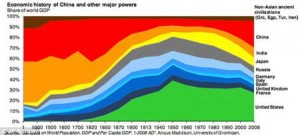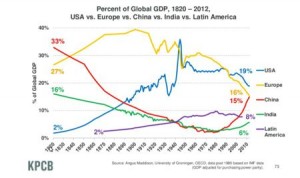China: Regaining its Rightful Place?
Listening to commentary about China’s woes, there seems to be a sense that China has done its dash and will move to slow or no growth. While this may be so, it flies in the face of the historic record.
China has been the world’s largest economy for most of the last two millennia. Its economic performance through the nineteenth century to the mid-twentieth century was an aberration. This period has been called the Great Divergence and was a time of increasing dominance of European nations. Various reasons have been advanced for this temporary dominance including technology, colonisation and world wide trade.
For many years China has been the world’s largest political union and a world leader in the development of technology. For five hundred years, from the tenth century to the fifteenth it was not only the largest economy in size but also in per capita income.
This is elegantly shown in the charts below. The charts are courtesy of the late Professor Angus Maddison of the University of Groningen, Netherlands. More information from Prof Maddison is available here.
China is well known for inventing the compass, gunpowder, paper and printing. However it was responsible for many more, lesser known inventions and discoveries. For example, China was the first to make alcoholic beverages and cookware. A few further examples relevant to the resource sector are as follows:
- The world’s oldest discovered blast furnaces, used for making iron, are in China, dated at 2nd to 3rd century BC. However cast iron weapons have been found in China that date as early as the 5th century BC.
- During the Han Dynasty (202BC to 220BC) the Chinese developed bore hole drilling techniques capable of drilling to depths of up to 600 metres.
- The famous Terracotta Army, dated at 201BC, has bronze spear tips coated in chromium. Chromium was not used in Europe until the 16th century AD!
- Coke was used in metallurgical furnaces during the Song Dynasty (960 to 1279AD). Natural gas from boreholes was used as fuel as early as the 4th century BC.
- The seismometer was invented by Zhang Heng in 132AD.
It is little surprise that China has been dominant for so long; a very large and politically stable population with very advanced technology. China was overtaken first by Europe, in the mid-19th century, and then by the United States, at the start of the 20th century, as the world’s largest economy. Both of these economies are in decline while China is in the ascendant.
Last Word
China’s growth will continue, although perhaps at a more muted pace than in recent times. It has a long history or being the world’s biggest economy and will probably become so again. Investors should ensure they are well placed to take rapid advantage of any improvement in conditions on the other side of the current downturn in the Australian resource sector. The main drivers will be the Chinese economy and the Australian dollar.


